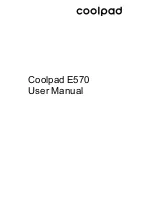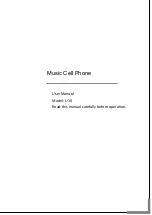
8. CALIBRATION
- 219 -
3. Measure output power as broadband power.
4. If the ACLR requirements, described in Table 11 are not met, calculate the test step necessary to
achieve the correct power. Use correlation from earlier calibrated units to calculate the new gain
setting (default correlation between VGA and output power is 1 dB and for QVGA 0.25dB).
5. Measure ACLR at this power level.
6. If the ACLR requirement is not met, reduce VGA and QVGA.
7. Measure and store the temperature at this point. This provides the value forTPmax.
8. This power and gain setting is to be used in calibration of TX power table.
9. Set gain to maximum power in medium gain mode and measure ACLR at this power
level.RFBiasshould be set to 1 andWPABiasshould be set to the same value as for maximum output
power.
10. If the requirements are not met, step the gain down and measure ACLR until the requirements are
met. The correlation between ACLR and output power is that 1 dB in power equals typical 3 dB in
ACLR. Use correlation from earlier calibrated units to calculate the new gain setting.
11. This power,Pmax measMG, is input to the calibration of TX power table.
12. Set gain to maximum power in low gain mode and measure ACLR at this power level.
RFBiasshould be set to 1 andWPABiasshould be set to the same value as for maximum output
power.
13. If the requirements are not met, step the gain down and measure ACLR until the requirements are
met. Use known correlation from earlier calibrated units to calculate the new gain setting.
14. This power,Pmax measLG, and gain setting provides input to the calibration of TX power table.
E. TX Power Table Calibration
- Purpose
The calibration data contained within the TX Power Table controls the gain for all types of power
change; including, the inner-loop power control and maximum output power of the platform.
The purpose of this calibration is to complete the TX Power gain table with values for VGA, QVGA,
RFBIAS, WPABias, and WDCDCREF that meet the specified requirements for inner-loop power-
control and Maximum output power. The size of hysteresis area must also be found.
These calibrations are designed to conform to the ME maximum output power, inner loop power
control, change of TFC and (PRACH preamble tolerances)requirements specified in 3GPP Spec
TS34.121.
- Procedure Proposal
This calibration consists of two parts: first measurements and then an off-line calculation. The
measurement results are used for characterizing the hardware so that proper settings can be
calculated for all tables. Settings and limitations are also used from maximum output calibration.
1. Perform measurements
(1) VGA behavior in LG (Low Gain) mode. PABias should not be offset and RFBIAS should be 1.
(2) VGA behavior in MG (Medium Gain mode). PABias should not be offset and RFBIAS should be 1.
(3) QVGA behavior in LG mode
(4) IQ-Gain behavior in LG mode.
(5) WPABias gain step size. Every eighth setting is measured twice. For better accuracy take the
average of each step pair. Interpolate the gain steps in between the averaged measured values.
Summary of Contents for U8120
Page 1: ...Service Manual Model U8120 Service Manual U8120 P N MMBD0035201 Date july 2004 Issue 1 0 ...
Page 52: ...3 TECHNICAL BRIEF 53 Figure Audio Section scheme ...
Page 62: ...3 TECHNICAL BRIEF 63 Figure TJATTE2 Block Diagram ...
Page 95: ...4 TROUBLE SHOOTING 96 4 5 Camera Trouble Camera control signals are generated by Marita ...
Page 96: ...4 TROUBLE SHOOTING 97 Camera control signals are generated by Marita ...
Page 97: ...4 TROUBLE SHOOTING 98 4 6 Main LCD Trouble LCD control signals are generated by Marita ...
Page 98: ...4 TROUBLE SHOOTING 99 4 7 Sub LCD Trouble ...
Page 99: ...4 TROUBLE SHOOTING 100 4 8 Keypad Backlight Trouble ...
Page 100: ...4 TROUBLE SHOOTING 101 ...
Page 101: ...4 TROUBLE SHOOTING 102 4 9 Folder ON OFF Trouble ...
Page 103: ...4 TROUBLE SHOOTING 104 4 10 Camera Detection Trouble ...
Page 104: ...4 TROUBLE SHOOTING 105 ...
Page 105: ...4 TROUBLE SHOOTING 106 4 11 Camera Flash Trouble ...
Page 106: ...4 TROUBLE SHOOTING 107 ...
Page 109: ...4 TROUBLE SHOOTING 110 1 R2619 3 CN963 1 21 40 20 2 Pin 38 39 ...
Page 110: ...4 TROUBLE SHOOTING 111 1 2 Measured 1khz Sine Wave Signal 3 Measured 1khz Sine Wave Signal ...
Page 113: ...4 TROUBLE SHOOTING 114 1 C2604 2 R2607 N2603 3 R2621 CN963 1 21 40 20 4 Pin 4 5 ...
Page 114: ...4 TROUBLE SHOOTING 115 5 Measured 1khz Sine Wave Signal ...
Page 117: ...4 TROUBLE SHOOTING 118 1 C2616 2 3 C2617 C2615 ...
Page 118: ...4 TROUBLE SHOOTING 119 2 Measured Some Noise Signal ...
Page 124: ...4 TROUBLE SHOOTING 125 Figure 15 Main Board I O connector and FET ...
Page 140: ...4 TROUBLE SHOOTING 141 ...
Page 152: ...4 TROUBLE SHOOTING 153 Figure 4 30 Connection for Checking Control Signal ...
Page 155: ...4 TROUBLE SHOOTING 156 Figure 4 32 Connection for Checking RF TX Level ...
Page 156: ...4 TROUBLE SHOOTING 157 To verify that the phone fulfils requirements on maximum output power ...
Page 162: ...4 TROUBLE SHOOTING 163 Figure 4 36 RX I Q signal ...
Page 164: ...4 TROUBLE SHOOTING 165 ...
Page 170: ...4 TROUBLE SHOOTING 171 N1300 5 1 5 Figure 4 41 Test Point of GSM DCS Tx path ...
Page 185: ...6 DISASSEMBLY INSTRUCTION 186 6 DISASSEMBLY INSTRUCTION ...
Page 186: ...6 DISASSEMBLY INSTRUCTION 187 ...
Page 187: ...6 DISASSEMBLY INSTRUCTION 188 ...
Page 188: ...6 DISASSEMBLY INSTRUCTION 189 ...
Page 189: ...6 DISASSEMBLY INSTRUCTION 190 ...
Page 190: ...6 DISASSEMBLY INSTRUCTION 191 ...
Page 191: ...6 DISASSEMBLY INSTRUCTION 192 ...
Page 192: ...6 DISASSEMBLY INSTRUCTION 193 ...
Page 233: ...8 CALIBRATION 234 Figure 8 16 Calibration Result from STATUS Tab View ...
Page 243: ... 244 10 PCB LAYOUT ...
Page 244: ... 245 10 PCB LAYOUT ...
Page 245: ... 246 10 PCB LAYOUT ...
Page 246: ... 247 10 PCB LAYOUT ...
Page 247: ... 248 11 EXPLODED VIEW REPLACEMENT PART LIST 11 1 EXPLODED VIEW ...
Page 249: ...11 EXPLODED VIEW REPLACEMENT PART LIST 250 ...
Page 250: ...11 EXPLODED VIEW REPLACEMENT PART LIST 251 ...
Page 252: ...11 EXPLODED VIEW REPLACEMENT PART LIST 253 ...
Page 253: ...11 EXPLODED VIEW REPLACEMENT PART LIST 254 ...
Page 254: ...11 EXPLODED VIEW REPLACEMENT PART LIST 255 ...
Page 255: ...11 EXPLODED VIEW REPLACEMENT PART LIST 256 ...
Page 256: ...11 EXPLODED VIEW REPLACEMENT PART LIST 257 ...
Page 257: ...11 EXPLODED VIEW REPLACEMENT PART LIST 258 ...
Page 258: ...11 EXPLODED VIEW REPLACEMENT PART LIST 259 ...
Page 259: ...11 EXPLODED VIEW REPLACEMENT PART LIST 260 ...
Page 260: ...11 EXPLODED VIEW REPLACEMENT PART LIST 261 ...
Page 261: ...11 EXPLODED VIEW REPLACEMENT PART LIST 262 ...
Page 262: ...11 EXPLODED VIEW REPLACEMENT PART LIST 263 ...
Page 263: ...11 EXPLODED VIEW REPLACEMENT PART LIST 264 ...
Page 264: ...11 EXPLODED VIEW REPLACEMENT PART LIST 265 ...
Page 265: ...11 EXPLODED VIEW REPLACEMENT PART LIST 266 ...
Page 266: ...11 EXPLODED VIEW REPLACEMENT PART LIST 267 ...
Page 267: ...11 EXPLODED VIEW REPLACEMENT PART LIST 268 ...
Page 268: ...11 EXPLODED VIEW REPLACEMENT PART LIST 269 ...
Page 269: ...11 EXPLODED VIEW REPLACEMENT PART LIST 270 ...
Page 271: ...Memo 272 ...
















































